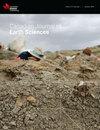Exploring the Moho beneath the Northern Canadian Cordillera, with seismically constrained gravity inversion.
IF 1.6
4区 地球科学
Q3 GEOSCIENCES, MULTIDISCIPLINARY
引用次数: 0
Abstract
The geometry and depth of the Moho beneath the Northern Canadian Cordillera and adjacent North American craton are modeled through the application of both cokriging and 3-D inversion of gravity data, integrated with sparse seismic depth estimates. Models require a regional density correction, with lower densities beneath the Cordillera than the craton. The lower densities are primarily attributed to a reduction in upper mantle density, ascribed to thermal expansion under regionally higher temperatures. The eastern margin of this low-density zone is broadly aligned with the rapid westward shallowing of the lithospheric-asthenospheric boundary. From the Cordillera to the North American craton, the Moho is broadly flat at a depth of ~32 km. A zone of deeper Moho (up to ~38 km) beneath the Mistry Creek embayment has a modeled mantle density that is of a colder cratonic signature, akin to the Mackenzie craton, and is interpreted to represent the preserved remnants of an old rift basin, that is a local focus of the diffuse seismicity. Southeast of the Fort Norman structure, seismicity is broadly focussed along the eastern edge of the low-density zone. Major structures such as the Denali and Tintina faults, with 100’s km of right-lateral displacement, separate zones of higher and lower upper mantle density, supporting the interpretation of their continuation into the upper mantle. Within the North American craton upper mantle density steadily increases towards the Great Bear magmatic zone, but increases more rapidly beneath the Slave craton in tangent with a deepening of the Moho.利用地震约束重力反演,探索北加拿大科迪勒拉山系下的莫霍面。
北加拿大科迪勒拉山系和邻近的北美克拉通下面莫霍面的几何形状和深度是通过应用重力数据的 cokriging 和三维反演,并结合稀疏的地震深度估计建立模型的。模型需要进行区域密度校正,科迪勒拉山系下的密度低于克拉通。密度较低的主要原因是上地幔密度降低,这归因于区域温度升高导致的热膨胀。该低密度区的东缘与岩石圈-对流层边界的快速西移大致吻合。从科迪勒拉山系到北美克拉通,莫霍面大致平坦,深度约为 32 千米。Mistry Creek Embayment 下方的莫霍深区域(最深约 38 千米)的地幔密度模型与麦肯齐克拉通类似,具有较冷的克拉通特征,被解释为代表一个古老裂谷盆地的残留物,是弥散地震的局部焦点。在诺曼堡构造的东南部,地震活动大致集中在低密度区的东部边缘。主要构造,如 Denali 断层和 Tintina 断层,具有 100 千米的右侧位移,将上地幔高密度区和低密度区分隔开来,支持对其延续到上地幔的解释。在北美克拉通内部,上地幔密度向大熊岩浆区稳步上升,但在斯拉夫克拉通下方,随着莫霍面的加深,上地幔密度的增加速度更快。
本文章由计算机程序翻译,如有差异,请以英文原文为准。
求助全文
约1分钟内获得全文
求助全文
来源期刊

Canadian Journal of Earth Sciences
地学-地球科学综合
CiteScore
2.80
自引率
7.10%
发文量
66
审稿时长
6-12 weeks
期刊介绍:
The Canadian Journal of Earth Sciences reports current research in climate and environmental geoscience; geoarchaeology and forensic geoscience; geochronology and geochemistry; geophysics; GIS and geomatics; hydrology; mineralogy and petrology; mining and engineering geology; ore deposits and economic geology; paleontology, petroleum geology and basin analysis; physical geography and Quaternary geoscience; planetary geoscience; sedimentology and stratigraphy; soil sciences; and structural geology and tectonics. It also publishes special issues that focus on information and studies about a particular segment of earth sciences.
 求助内容:
求助内容: 应助结果提醒方式:
应助结果提醒方式:


